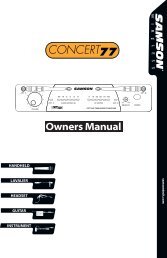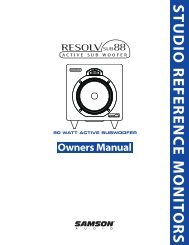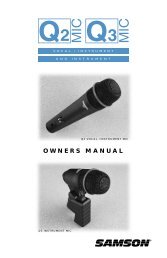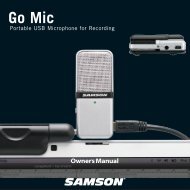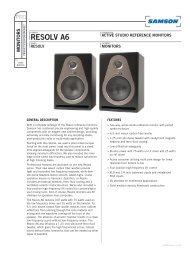You also want an ePaper? Increase the reach of your titles
YUMPU automatically turns print PDFs into web optimized ePapers that Google loves.
Controls and Functions<br />
MONO INPUT CHANNEL SECTION<br />
ENGLISH<br />
The following section details each part of the <strong>MDR6</strong>’s MONO INPUT CHANNELS including the GAIN control, 3-BAND EQ,<br />
AUX send, RECORD, PAN and LEVEL controls. The input channels one through four on the <strong>MDR6</strong> feature high quality,<br />
discrete transistor pre-amp providing transparency and extended dynamic range. The combination connector accepts<br />
a standard XLR mic cable for microphone level signals, or a standard 1/4" phone cable, either balanced (TRS – TIP/ RING/<br />
SLEEVE) or unbalanced (TS – TIP/SLEEVE) for line level signals.<br />
1<br />
2<br />
3<br />
4<br />
GAIN<br />
The <strong>MDR6</strong>’s pre-amp stage has a variable GAIN control with a range of 5 to 60dB on the<br />
MIC input and –26 to +26dB on the LINE input.<br />
CLIP LED<br />
The <strong>MDR6</strong>’s MIC/LINE pre-amp also includes a CLIP LED which, when illuminated, indicates<br />
that the signal is peaking or overloading. To reduce distortion, lower the GAIN control<br />
to keep this LED from staying on.<br />
CHANNEL EQUALIZER<br />
The <strong>MDR6</strong> input channels feature a 3-band equalizer allowing you to adjust the high,<br />
mid, and low frequencies independently on each channel. The channel’s frequency<br />
response is flat when the knobs are in the "12:00" position. Rotating the knob towards<br />
the right will boost the corresponding frequency band by 15dB, and rotating it towards<br />
the left will cut the frequency by 15dB. The frequency centers, range of boost or cut, and<br />
equalizer type for each band are as follows:<br />
High: 12KHz +/- 15dB shelving type<br />
Mid: 2.5KHz +/- 15dB peaking type<br />
Low: 80Hz +/- 15dB shelving type<br />
AUX SEND<br />
The AUX section is often used for a monitor mix in a live sound mixing, or for a headphone<br />
mix in a recording application. Each input channel includes an Aux send which<br />
controls the amount of that channel’s signal that is sent to the Aux bus.<br />
2<br />
3<br />
4<br />
1<br />
6



